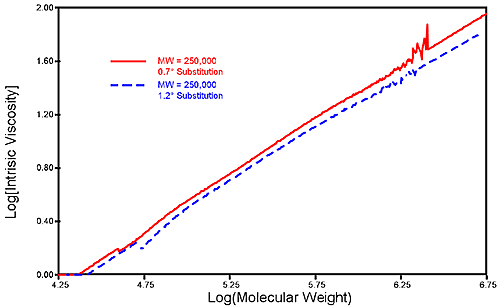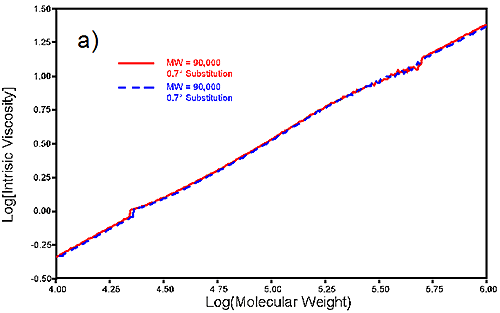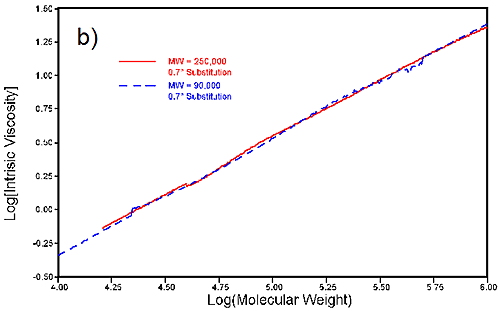Sodium carboxymethyl cellulose, or CMC, was introduced commercially over thirty years ago. It is used in a wide variety of applications, such as pharmaceuticals, cosmetics, textiles, food, and paper, where suspending, binding, stabilizing, thickening, and film-forming properties are required. The degree of substitution (carboxymethyl groups per anhydro-glucose unit) is an important factor in CMC performance. The degree of substitution can be easily distinguished by triple detection gel permeation chromatography (TD-GPC). This application communication shows how the use of the sensitive Mark-Houwink plot can be used to assess the substitution of CMC.
Three samples of sodium carboxymethyl cellulose were studied using TD-GPC. The first two samples had a weight average molecular weight of 250,000 g/mol with substitution of 1.2° and 0.7°. The third sample also had a substitution of 0.7° but the weight average molecular weight was lower at 90,000 g/mol.
The chromatographic system used was the Viscotek GPCmax. The eluent was aqueous based. The GPCmax degassed the eluent and pumped it at a constant flow rate of 1.0 mL/min. The autosampler of the GPCmax was used to inject 100 µL of the solution prepared at approximat ely 0.5 mg/ml. The separation was performed on a 30 cm column, TSK GMPWxl.
The detection was carried out using a Viscotek Triple Detector Array (TDA). The first detector was a static light scattering followed by a differential refractometer (RI) and then a differential viscometer, all three detectors in series for maximum signal and ease of use.

|
Figure 1 shows the Mark-Houwink plots for two standards of identical molecular weight, but with different degrees of substitution. The molecular structure of the two standards is similar, as indicated by the region of the plots, however, the standard with1.2° substitution falls below the standard with 0.7° substitution. At the same molecular weight, it has a lower intrinsic viscosity, which indicates a more heavily substitution. The use of a light scattering alone or a viscometer alone would not have shown the difference in the substitution in this case. The Mark-Houwink plot shows a small but clear difference.

|

|
To verify the results two individual injections of carboxymethyl cellulose of 90,000 molecular weight and 0.7° substitution were made, with excellent reproducibility. This is seen in the Mark-Houwink plot in figure 2a. The plots overlay exactly.
A final comparison was made between two samples of different molecular weight and the same degree of substitution. Figure 2b shows the Mark-Houwink plot for a 90,000 and 250,000 g/mol CMC polymer with the same degree of substitution (7°). The structure of the two samples is shown to be identical by the Mark-Houwink plot since both curves overlay perfectly.
Aside from molecular structure, many other properties are available from the TD-GPC triple detector system, including full molecular weight and intrinsic viscosity distributions. Hydrodynamic radius values can be calculated directly from knowledge of the molecular weight and intrinsic viscosity. The triple detector system can accurately determine RH down to less than 1 nm.
J. I. Kroschwitz, ed., Encyclopedia of Polymer Science and Engineering, Vol. 3, John Wiley &Sons, Inc., 1985.